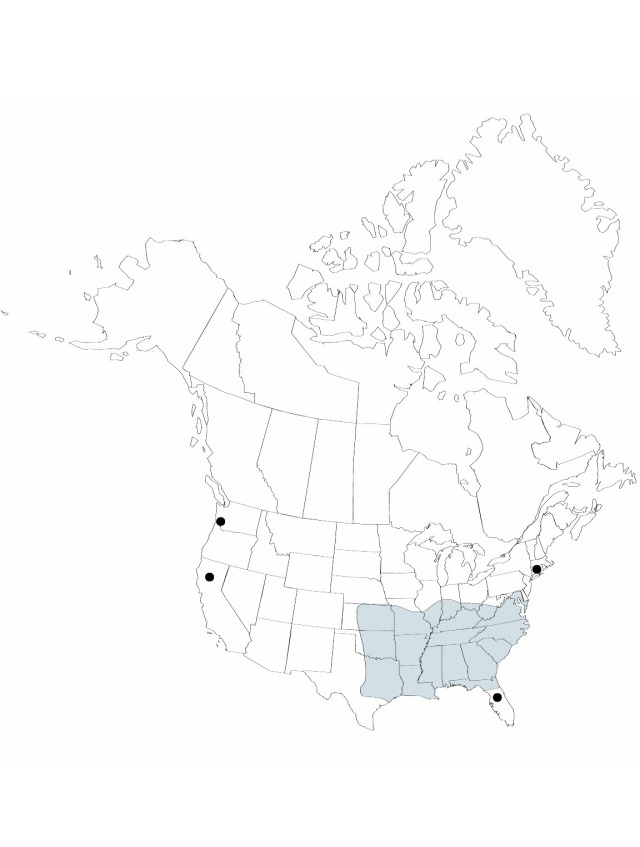Difference between revisions of "Juncus diffusissimus"
Proceedings of the Academy of Natural Sciences of Philadelphia 14: 9. 1862.
FNA>Volume Importer |
imported>Volume Importer |
||
| (5 intermediate revisions by 2 users not shown) | |||
| Line 6: | Line 6: | ||
|place=14: 9. 1862 | |place=14: 9. 1862 | ||
|year=1862 | |year=1862 | ||
| + | }} | ||
| + | |special_status={{Treatment/ID/Special_status | ||
| + | |code=E | ||
| + | |label=Endemic | ||
}} | }} | ||
|basionyms= | |basionyms= | ||
| Line 23: | Line 27: | ||
|elevation=10–1000 m | |elevation=10–1000 m | ||
|distribution=Ala.;Ark.;Calif.;Conn.;Fla.;Ga.;Ill.;Ind.;Kans.;Ky.;La.;Md.;Miss.;Mo.;N.C.;Ohio;Okla.;S.C.;Tenn.;Tex.;Va.;Wash.;W.Va.;probably South America. | |distribution=Ala.;Ark.;Calif.;Conn.;Fla.;Ga.;Ill.;Ind.;Kans.;Ky.;La.;Md.;Miss.;Mo.;N.C.;Ohio;Okla.;S.C.;Tenn.;Tex.;Va.;Wash.;W.Va.;probably South America. | ||
| + | |introduced=true | ||
|tables= | |tables= | ||
|references= | |references= | ||
| Line 31: | Line 36: | ||
-->{{#Taxon: | -->{{#Taxon: | ||
name=Juncus diffusissimus | name=Juncus diffusissimus | ||
| − | |||
|authority=Buckley | |authority=Buckley | ||
|rank=species | |rank=species | ||
| Line 46: | Line 50: | ||
|publication title=Proceedings of the Academy of Natural Sciences of Philadelphia | |publication title=Proceedings of the Academy of Natural Sciences of Philadelphia | ||
|publication year=1862 | |publication year=1862 | ||
| − | |special status= | + | |special status=Endemic |
| − | |source xml=https:// | + | |source xml=https://bitbucket.org/aafc-mbb/fna-data-curation/src/2e0870ddd59836b60bcf96646a41e87ea5a5943a/coarse_grained_fna_xml/V22/V22_75.xml |
|genus=Juncus | |genus=Juncus | ||
|subgenus=Juncus subg. Septati | |subgenus=Juncus subg. Septati | ||
Latest revision as of 21:32, 5 November 2020
Herbs, perennial, cespitose, 2.5–6.5 dm. Culms erect, terete, 1–3 mm diam., smooth. Cataphylls 0–1, maroon or dark green, apex obtuse. Leaves: basal 1, cauline 2–3; auricles 1–2.1 mm, apex rounded, membranaceous; blade maroon or dark green, terete to compressed, 3–20 cm × 1–2.4 mm. Inflorescences terminal panicles of 30–70(–130), 5–20 cm, branches spreading; primary bract erect; ; heads (1–)2–10-flowered, hemispheric or narrower, 5–10 mm diam. Flowers: tepals green to straw-colored, lanceolate, apex acute; outer tepals (2–)2.6–3.2 mm; inner tepals (1.8–)2.3–3 mm; stamens 3, anthers 1/2–2/3 filament length. Capsules exserted, , straw-colored, 1-locular, linear-lanceoloid, 4–5.2 mm, apex acute, valves separating at dehiscence. Seeds oblong-ellipsoid, 0.3–0.4 mm, not tailed; body clear yellow-brown.
Phenology: Fruiting summer.
Habitat: In soft mucky substrates, marshy shores, sloughs, occasionally in wet wooded places, often in shallow water, commonly abundantly colonizing wet, sandy- alluvial outwash in ditches and clearings
Elevation: 10–1000 m
Distribution

Introduced; Ala., Ark., Calif., Conn., Fla., Ga., Ill., Ind., Kans., Ky., La., Md., Miss., Mo., N.C., Ohio, Okla., S.C., Tenn., Tex., Va., Wash., W.Va., probably South America.
Discussion
Selected References
None.